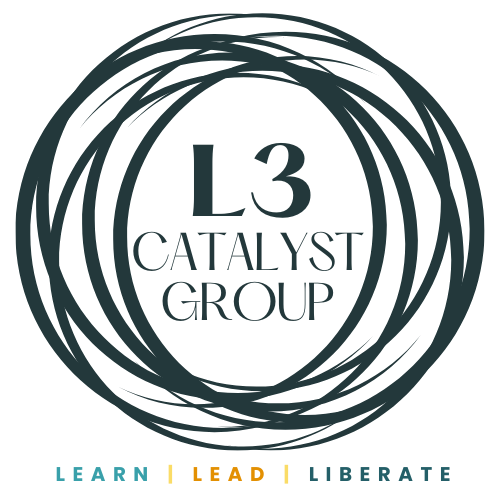Change Leadership Craft
In today's fast-moving and unpredictable world, it can feel like everything is change. Leadership is no longer just about applying technical skills to manage-the-heck-out-of changes or crises —it’s about grounding and regrounding during chaotic change as a catalyst for connection and thriving.
"Okay, okay, we get it that change is the only constant, but this is ENOUGH already!" Said an executive client recently.
Almost all of my Process Consulting and Coaching clients are figuring out how to engage with change instead of avoiding and silencing it.
It can be really hard, right? We constantly talk about change, which can be OK...until we have to DO it when we don't choose it.
Ya'll know that I write about things here that challenge me, things I'm learning and grappling with. We are being confronted with SO MUCH CHANGE; I want to talk about change today because:
The waves of change come crashing so fast lately that we can hardly gasp for a breath of air before we drown in it.
I recently re-read the article "From Change Management to Change Leadership: Embracing Chaotic Change in Public Service Organization (2008) and re-discovered great points that I'd like to share. I hope they speak to and encourage you.

From Change Management to Change Leadership: Inspiration to Drive Meaningful Change
Many traditional change management efforts fail because they focus too much on tools, strategies, and structures while neglecting the human and relational aspects of change (IBM, 2004). Instead, effective change leadership prioritizes people, identity, and conversations, fostering environments where transformation can emerge organically (Karp & Helgø, 2008).
Shifting from Control to Influence
Many leaders attempt to control change through rigid frameworks, yet research shows that change is inherently unpredictable (Stacey, 2003). Public and private sector organizations alike struggle because they over-rely on managerial tools rather than focusing on human interactions and the psychology of change (Diefenbach, 2007).
To succeed, leaders must move beyond mechanistic change management and embrace the complexity of human relationships. Instead of enforcing change from the top down, they must learn to influence and guide emergent patterns of interaction within their organizations (Shaw, 2002).

The Power of Identity and Conversation
Organizational change is not just about shifting structures—it is about reshaping identities. Research indicates that people resist change not because they dislike it, but because it threatens their sense of self (Cozolino, 2006). This means that leaders must engage people in conversations that help them redefine their roles and contributions in a way that aligns with the evolving organization.
Shifting the way people talk about change within an organization is a key leadership skill (Weick, 2001). As people interact, negotiate meaning, and share narratives, they co-create the future of the organization. Leaders who focus on facilitating these meaningful conversations rather than enforcing rigid change plans will be far more successful (Rock & Schwartz, 2006).
How Leaders Can Drive Meaningful Change
🔹 Lead with Purpose: Clearly communicate why the change matters, linking it to the organization’s core values and mission (Senge, 1990).
🔹 Encourage New Conversations: Change happens when people start talking differently—challenging assumptions and co-creating new realities (Shaw, 2002).
🔹 Empower, Don’t Dictate: Instead of top-down mandates, foster a sense of ownership and agency among employees (Kim & Mauborgne, 2005).
🔹 Embrace Uncertainty: Change is messy and unpredictable—great leaders accept ambiguity and lead through influence rather than control (Griffin, 2002).
🔹 Model the Change: Leadership is not about directing others to change—it’s about embodying transformation in a way that inspires others to follow (Badaracco, 2006).
Becoming a Change Leader
Leaders who embrace chaotic change, rather than resist it, unlock new possibilities for their organizations. By focusing on people, fostering adaptive conversations, and shaping identity and culture, they don’t just manage change—they lead it.
🔹 Instead of imposing rigid change plans, cultivate self-organization and emergent leadership within the organization (Beinhocker, 2006).
🔹 Recognize that resistance to change is often a survival mechanism—leaders must acknowledge fears and work with people’s intrinsic motivations (Diefenbach, 2007).
🔹 Create environments where people feel valued, heard, and engaged in shaping the future, rather than feeling like passive recipients of change initiatives (Rock & Schwartz, 2006).

The challenge isn’t just to respond to change—it’s to lead it with courage, clarity, and a deep commitment to human connection. Leaders who take this approach will turn uncertainty into opportunity, building resilient, forward-thinking organizations that thrive in an unpredictable world.
I hesitated to share this blog post today because the last thing leaders need are more checklists and trite quips to reinforce things we aren't doing. But this post is not that; you CAN do this.
I SEE and support people, leaders, and teams every day that invest in their future, invest in themselves, and truth-tell to grow spaces and organizations that are marked by increased health, increased thriving, increased connectedness, and increased outcomes even, and especially, in these ridiculously challenging times.

You got this friends. Don't give up on finding the ways that you and your people can develop your craft of change leadership.
The world needs you in your messiness, your humor, your passion, your love, your giftedness.
It's for times such as these, that we are here, to create spaces of love, liberation, and joy.
I believe in you.
Fellow leaders and learners, I wish you courage, rest, and Beloved Community for the journey. Together we catalyze a brave, bold, and liberatory future.
Peace to you,
.png?width=116&height=58&name=Dee%20(1).png)
Primary Source:
Karp, T., & Helgø, T. I. T. (2008). From Change Management to Change Leadership: Embracing Chaotic Change in Public Service Organizations. Journal of Change Management, 8(1), 85-96. https://doi.org/10.1080/14697010801937648

March 26, 2025





Comments